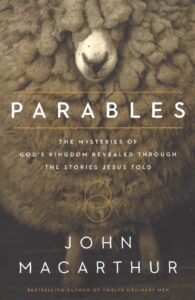MacArthur Exposits the Parables

By Stephen W. Hiemstr
Macarthur, John. 2015. Parables: The Mysteries of God’s Kingdom Revealed Through the Stories Jesus Told. Nashville: Thomas Nelson.
Review by Stephen W. Hiemstra
One method for determining the theology of a Christian author is to start by reviewing the scriptural index. Polemical writers often neglect to offer a scriptural index because they hold the authority of scripture lightly. A popular school of thought among biblically inclined authors called biblical theology is obvious by a balanced distribution of citations across the biblical text. Old Testament scholars will cite mostly from the Old Testament; likewise, New Testament scholars will cite mostly from the New Testament.
Introduction
John MacArthur’s Parable: The Mysteries of God’s Kingdom Revealed Through the Stories Jesus Told cites scripture from across the biblical text with emphasis on the New Testament. This is an important insight because MacArthur offers no obvious objective in writing, as would be the case for academic authors. The book’s back-cover states:
“Master expositor and Bible commentator John MaArthur has spent a lifetime explaining the Word of God in clear and comprehensible terms. In Parables, he helps Christians understand the essential lessons Jesus had for his people, lessons contained in the most famous and influential short stories the world has ever known.”
These lessons explain what disciples need to know about a dozen of Jesus’ parables and related teaching (xxiv).
Background and Organization
John MacArthur (1939 -) was born into a family of pastors. He attended Bob Jones College and the Free Methodist Church’s Los Angeles Pacific College. He earned a master’s of divinity from Talbot Theological Seminary, where was also granted an honorary Doctor of Divinity. He also received an honorary Doctor of Divinity from Grace Graduate School in Winona Lake, Indiana. He is a pastor and a televangelist. He is an author of numerous books, of which The MacArthur Study Bible is especially popular. In the text, he references: The MacArthur New Testament Commentary (xxiv).
MacArthur writes in ten chapters preceded by an introduction and followed by acknowledgments, an appendix, notes, indices, and a short biography. The chapters are:
Introduction
One Ominous Day in Galilee
A Lesson about Receiving the Word
A Lesson about the Cost of Discipleship
A Lesson about Justice and Grace
A Lesson about Neighborly Love
A Lesson about Justification by Faith
A Lesson about Faithfulness
A Lesson about Serpentine Wisdom
A Lesson about Heaven and Hell
A Lesson about Persistence in Prayer (ix-xi)
From the chapters titles we see an emphasis on expository teaching. MacArthur’s scholarly acumen becomes obvious as he translates key phrases from the Greek and Hebrew.
Definition of a Parable
MacArthur (xxiv-xxix) offers a detailed series of definitions of a parable, recognizing that no one definition suits all of Jesus’ parables. One such definition focused on the New Testament is: “A parable extends [a] comparison into a longer story or more complex metaphor, and the meaning (always a point of spiritual truth) is not necessarily obvious.” (xxiv) Another draws on the Old Testament use of the Hebrew, mashal, “which can refer to a prophetic saying, a proverb, a riddle, a discourse, a poem, a short story, a similitude—almost any kind of pithy maxim or anecdote.” (xxv)
What generally sets Jesus’ parables apart from Rabbinic parables is the focus on the kingdom of God rather explaining a verse of scripture (Blomberg 2012, 76).
Turning Point
MacArthur points to a specific day recorded in Matthew 12 when Jesus began teaching in parables. Jesus’ disciples were chastised by the Pharisees for eating grains of wheat on the Sabbath. When Jesus then enters their synagogue to teach, the Pharisees confront Jesus with a man with a withered hand and ask him if it is lawful to heal on Sabbath. After Jesus heals the man, the Pharisees begin to conspire to kill him (Matt 12:14). Recognizing the threat posed, Jesus begins to teach with parables, as recorded in Matthew 13. His first parable is the parable of the Sower.
The explanation of the parable of the Sower speaks to the purpose of parabolic stories: “This is why I speak to them in parables, because seeing they do not see, and hearing they do not hear, nor do they understand.” (Matt 13:13). In other words, the parable is used to judge a person’s heart: believers understand; unbelievers refuse to. The parable of the wheat and tares addresses this heart issue. MacArthur writes: “By deliberately rejecting the truth [Jesus’ healing by way of the Holy Spirit], the sworn enemies of Christ had lost the privilege of hearing any more plain truth from His lips.” (14)
This turning point in Jesus’ ministry is immediately applicable today. Because of mass media, virtually the entire planet has heard of Jesus Christ and his teaching. Because of the predominant philosophy of materialism today, postmodern people have trouble with anything transcendent and fill their hearts with divine substitutes (idols), primarily ecstatic experiences of various kinds. These include drugs, hypersexuality, unnecessary risk taken, workaholism, and just plain partying. The transcendence of God pointed to by Jesus’ parables are defined away.
Assessment
John MacArthur’s Parable: The Mysteries of God’s Kingdom Revealed Through the Stories Jesus is a plainspoken guide to studying Jesus’ parables focused on the needs of disciples. Anyone serious about their study of Jesus’ ministry should find this book helpful.
References
Blomberg, Craig L. 2012. Interpreting the Parables. Downers Grove: IVP Academic.
Footnotes
https://en.wikipedia.org/wiki/John_Ma...
MacArthur Exposits the Parables
Also see:
The Who Question
Preface to a Life in Tension
Other ways to engage online:
Author site: http://www.StephenWHiemstra.net
Publisher site: http://www.T2Pneuma.com
Newsletter at: https://bit.ly/Fall_xx22, Signup
The post MacArthur Exposits the Parables appeared first on T2Pneuma.net.



